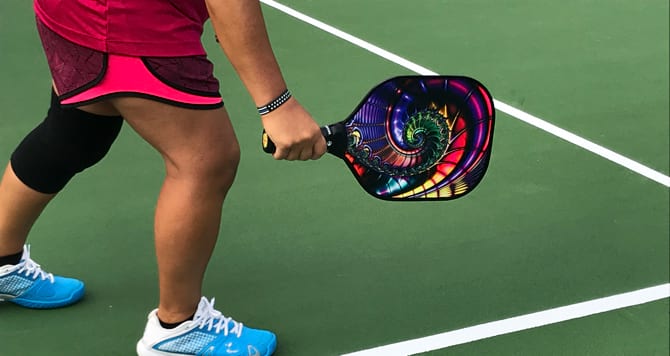Paddle specifications in pickleball game
The USAPA has very few restrictions on what materials can be used to make a paddle, as long as it’s rigid and made of a non-compressible material. The surface of the paddle can’t have holes or indentations in it. The surface must be smooth and feature no rough texturing.
The goal is to use a paddle that doesn’t allow a player to put any extra spin on the ball, as that would be unfair. The surface of the paddle may be painted, but it can’t be so reflective that it causes glare that will disrupt the game. The paddle is not to exceed a length of 17 inches, but there is no restriction on how thick a paddle can be, nor are there any restrictions on weight.
2.1. Material
The paddle may be made of any material deemed safe and not prohibited by these rules. The paddle shall be made of rigid, non-compressible material meeting the criteria located on the USAPA and IFP websites.
2.2. Surface
The paddle hitting surface shall not contain holes, indentations, rough texturing, or any objects or features that allow a player to impart additional spin on the ball. Paddle roughness is determined using a Starrett SR160 Surface Roughness Tester (or equivalent). The allowable limits for roughness shall be no greater than 30 micrometers (µm) on the Rz reading (average maximum height, peak to valley) and no greater than 40 micrometers on the Rt reading (average maximum height, peak to valley). All readings will be taken in six different directions.
2.2.1. Paint. The surface may be painted but must otherwise adhere to the general surface requirements.
2.2.2. Reflection. The paddle hitting surface shall not be adversely reflective, such that it has the potential to obscure the vision of opposing player(s). Paddles shall not have any measurement exceeding 80 GU. Measurement is to be taken at the universal measurement angle of 60 degrees with ETB-0833 Self-Calibration 20° 60° 85° Surface Glossmeter Tester 0-200 GU or equivalent.
2.2.3. Depictions. Any writing or pictures on the paddle must be in good taste.
2.3. Size
The combined length and width, including any edge guard and butt cap, shall not exceed 24 inches (60.96 cm). The paddle length cannot exceed 17 inches (43.18 cm). There is no restriction on paddle thickness.
2.4. Weight
There is no restriction on paddle weight.
2.5. Alterations
Altered paddles must meet all specifications.
2.5.1. The only alterations or additions that may be made to a commercially made paddle are edge guard tape, lead tape, changes to the grip size or grip wrap, and name decals and/or other identification markings on the paddle face.
2.5.2. Decals and tape can extend no farther than 1.0 inch (2.54 cm) above the top of the grip nor more than 0.5 inch (1.27 cm) inside the outer edge of a paddle or, if an edge guard is in place, 0.5 inch inside the edge guard.
2.5.3. Handwritten markings are allowed on the paddle’s playing surface as long as they do not impact the surface roughness and are in good taste. No aftermarket graphics are allowed on a commercially made paddle other than “handwritten” pen markings.
2.6. Prohibited surface features and mechanical features
2.6.1. Anti-skid paint or any paint textured with sand, rubber particles, or any material that causes additional spin.
2.6.2. Rubber and synthetic rubber.
2.6.3. Sandpaper characteristics.
2.6.4. Moving parts that can increase head momentum.
2.6.5. Removable parts. No removable parts except for paddle grip adjustments and/or grip wraps and lead tape on the paddle edge.
2.6.6. Springs or spring-like material.
2.6.7. Flexible membranes or any compressible material that creates a trampoline effect.
2.6.8. Electrical, electronic, or mechanical assistance of any sort.
2.7. Model designation
The manufacturer must have a clearly marked brand and model name or model number on the paddle. Paddles with different core material, surface material, or other significant differences must have a unique name or number.
2.8. Homemade paddles
Paddles that are not commercially made are not permitted (e.g., homemade paddles).





